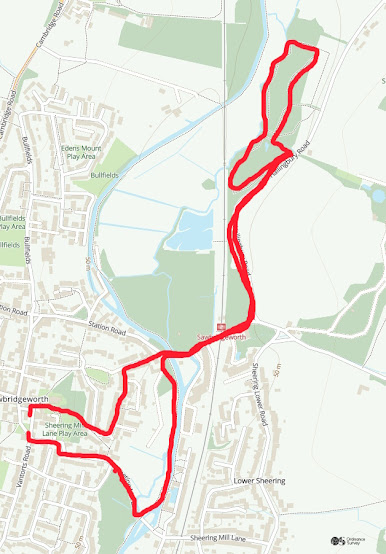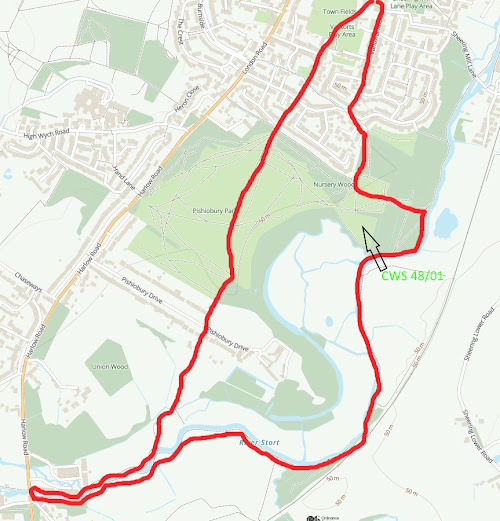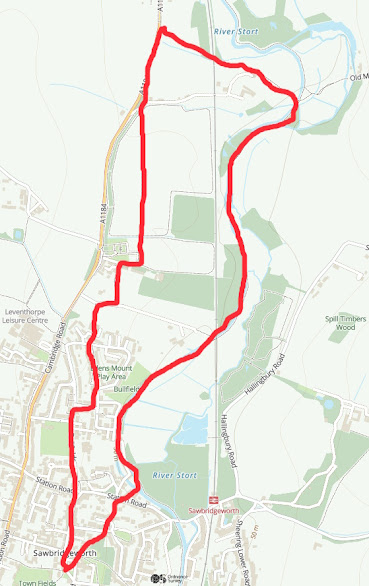Walk 11 Sawbridgeworth Marsh Nature Reserve.
The idea of Nature Walks around Sawbridgeworth Parish is to make people aware of the wonderful wildlife resource we have locally and within walking distance. Each route is shown in a red line on an Ordnance Survey map. Theoretically, all start and finish at the Fair Green but you can of course drop in at any point. Rather then being told what to look for, I have just put pointers in along the route because I want people to look for themselves and make their own discoveries! This will mean much more to everyone! They are not intended as route marches so take your time and stop and look! All the routes follow Footpaths but inevitably, there are places where the walks have to cross roads. Do please take extreme care and follow all the safety guidelines to avoid accidents. County Wildlife sites are marked CWS and a code number.
Walk 11. This Walk takes you from the Fair Green down to the river and then over the station. From this point turn left along the Hallingbury Road in order to get to the Nature Reserve. There is no alternative but to walk along the road which can be quite busy so do please take extreme care and be prepared to hop up on the bank to be out of the way of passing cars. Observe the general rule of walking on the right hand side but use your common sense to cross over where this might mean you could be in a blind spot for drivers. This walk is probably best undertaken in early June when you can see the marshland flora at its best but it is an interesting walk at all times of the year. The Nature Reserve is one of Sawbridgeworth's best kept secrets but it was described in The Flora of Herts 1960 by Dr John Dony as 'one of the finest marshes in Hertfordshire'. The walk is 2.25miles and allow two hours according to how long you expect to be on the Marsh. Going easy but be aware that it is a Marsh so wear appropriate footwear.
- Leave the Fair Green and walk down through the churchyard to Church Crescent. Note the variety of mature trees in the churchyard.
- Continue walking down through the end of Church Walk and then into Forebury Avenue. Note the variety of street trees including ornamental Plum and Crab Apple. Note also traditional garden hedges.
- Follow the road through to the Forebury and turn right, down to Station Road. At this junction, note the triangle of land on the right known as Shop Mead. Note also the colony of feral pigeons which nest under County Bridge. As you cross over the bridge peer down into the river and look for water weeds such as strap weed waving in the current.
- Follow the pavement towards the station looking over the metal fence on your left to see the Old River Stort backwater where in the summer you can see Yellow Water Lilies and possibly shoals of fish. As you continue on, note the areas of Common Reed on the left as well as the area of wet Willow woodland which has developed on what was once a grazing field.
- Crossing over the level crossing, note the large Plane trees growing on the left as well as the flow of water emanating from the spring line which also feeds the Marsh Nature Reserve.
- Turn left into Hallingbury Road taking great care regarding traffic as advised above. The area on your left is a County Wildlife Site which needs a biodiversity survey carrying out. CWS 48/017
- As you walk along the road taking great care, note some old Oak trees growing on the bank which date out at about 1800 planting and will almost certainly be part of the Great Hyde Hall estate, the buildings of which can be seen across the field on your right-hand side.
- Take note of the crop being cultivated on the gravelly field to your right. This gravelly field is one of the very old river terraces which have developed over the time since the last Ice Age and are the result of steady movement of the river backwards and forwards across its floodplain.
- As you go around the sweeping right-hand bend note the roadside hedge on the left which has quite a good variety of trees and shrubs including Field Maple, Hazel, Blackthorn and Wild Cherry.
- As you approach the Lodge house on your right note the stream coming down from Great Hyde Hall. This stream is partly from a spring fed lake at the top of the hill and also from the sewage treatment works from the houses.
- Find the entrance to the Nature Reserve on your left by the large Oak Tree. It is up to you how long you spend on the Reserve but follow the network of paths and take note of any plants and animals you see. A properly described seasonal route will be developed later on for you to follow using this blog medium.
- Having completed a circuit of the Reserve there is no option but to retrace your footsteps back to first of all the Station and then to County Bridge. At this point, turn left along the towing path, having a proper look at Shop Mead.
- Follow the towing path to Sheering Mill, noting the old Maltings buildings on the left over the river. Note also the spillway leaving the canal on the right this is the old river which travels across the floodplain, under Sheering Mill Lane to rejoin the canal below the lock.
- Turn right and follow Sheering Mill Lane back towards the town. In the summer you can see large areas of Golden Rod and also Himalayan Balsam, both of which are invasive species. Note also the bed of Common Reed, especially on your left which once again indicates the existence of a freshwater spring running along the bottom of the rising land.
- Follow the road up the hill to the Z bends, again taking great care of cars. As you approach the Fair Green note the old soft red brick walls on both sides of the Lane. These walls provide good and unusual habitat not only for a variety of plants but also invertebrates such as spiders.



Comments
Post a Comment